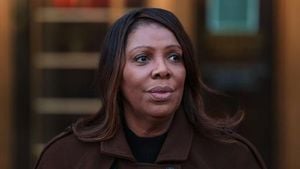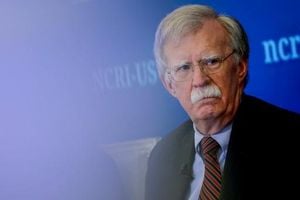The U.S. Federal Reserve Board is stepping into the spotlight this autumn, not just for its monetary policy decisions, but for a pivotal conference on payments innovation scheduled for October 21, 2025. The announcement, made on September 3, 2025, comes at a time when the central bank’s independence is under intense scrutiny, with political pressures mounting and the future of its leadership hanging in the balance.
The upcoming conference, according to the Federal Reserve Board, is set to tackle some of the most pressing and forward-looking issues in the world of finance. Topics on the agenda include the use cases and business models for emerging stablecoins, the tokenization of financial products and services, the integration of artificial intelligence in payment systems, and the convergence of traditional and decentralized finance. The event will be broadcast publicly via the Fed’s official website, signaling a commitment to transparency and broad stakeholder engagement.
Governor Christopher Waller, speaking on behalf of the Board, underscored the importance of innovation in the payments sector. "Innovation has been a constant in payments to meet the changing needs of consumers and businesses," Waller stated, as reported by Cointelegraph. "I look forward to examining the opportunities and challenges of new technologies, bringing together ideas on how to improve the safety and efficiency of payments, and hearing from those helping to shape the future of payments."
This focus on innovation isn’t happening in a vacuum. The conference announcement closely follows the July 2025 passage of the GENIUS Act, a landmark bill establishing a regulatory framework for payment stablecoins. The legislation mandates that both the U.S. Treasury and the Federal Reserve issue comprehensive regulations before any implementation of payment stablecoins can proceed. This move aims to balance the promise of digital currencies with the need for financial stability and consumer protection.
Yet, while the Fed is looking to the future of payments, it’s simultaneously grappling with a storm of political controversy. President Donald Trump’s repeated attempts to remove Governor Lisa Cook from her position—ostensibly over allegations of mortgage fraud—have ignited a fierce debate about the central bank’s independence. Cook, who has not been charged with any crime, has filed a lawsuit to block her removal, arguing that the accusations are a pretext for the President’s bid to exert control over the Fed. Legal experts and economists alike are watching the case closely, as it could ultimately reach the Supreme Court and set a precedent for the relationship between the White House and the central bank.
The stakes are high. According to AP News, about 600 economists signed an open letter on September 2, 2025, warning the administration that "no Governor should be removed absent a clear, documented ‘for cause’ basis that would withstand judicial scrutiny." They cautioned, "Weakening that standard increases monetary policy uncertainty and forces markets to price political risk into interest rates, raising those rates and costs for families and businesses." The letter urged elected officials to "refrain from rhetoric or actions that erode the Federal Reserve’s independence."
The controversy has drawn international attention as well. European Central Bank President Christine Lagarde, speaking to The Guardian, warned that undue political pressure on the U.S. central bank could pose a "serious danger" to the world economy. Lagarde emphasized that if U.S. monetary policy were to become subject to political directives, it could result in significant economic instability, given America’s outsized role in global finance.
President Trump’s efforts to influence the Fed go beyond the Cook affair. He has publicly criticized Fed Chair Jerome Powell and has pressed for lower interest rates, arguing that the central bank should be more responsive to political priorities. Some in his administration, including top economic adviser Stephen Miran, have floated proposals to change the Fed’s structure to make it easier for the president to remove governors. Miran contends that "increased accountability is necessary in a democratic society," while other officials, such as Vice President JD Vance, have suggested the Fed should be subject to more direct democratic input.
Such proposals have alarmed many economists, who point to historical precedents where political interference in monetary policy led to damaging inflation and economic instability. Douglas Elmendorf, former director of the Congressional Budget Office, highlighted the dangers of a politicized central bank, noting that "if the Fed were to fall under the control of the executive branch, it could lead to years of high inflation," as seen in the 1960s and 1970s. During those decades, Presidents Lyndon Johnson and Richard Nixon pressured the Fed to keep interest rates low to advance their policy agendas, with disastrous results for price stability.
Legal experts agree that the Federal Reserve’s structure is unique among federal agencies. A prior Supreme Court opinion described the Fed as a "uniquely structured, quasi-private entity," meaning its leadership can only be removed "for cause." This legal safeguard is designed to insulate monetary policy from short-term political pressures and ensure decisions are made in the long-term interest of the economy.
Still, the outcome of the Cook case could have far-reaching implications. If President Trump succeeds in replacing Cook with a nominee aligned with his economic agenda, he could gain a majority on the Fed’s governing board, potentially reshaping the direction of U.S. monetary policy for years to come. As AP News notes, this would be an unprecedented shift in the balance of power between the executive branch and the central bank.
Meanwhile, the Fed’s October conference is shaping up to be more than just a technical discussion about payment systems. It’s a forum that will highlight both the promise of financial innovation and the challenges of maintaining institutional independence in a politically charged era. The event is expected to draw a wide array of participants, from experts in traditional finance to leaders in the burgeoning field of decentralized finance—a sign that the future of money is, quite literally, up for debate.
As the U.S. navigates these turbulent waters, the world will be watching. The outcome could redefine not only how Americans pay and get paid, but also how the nation’s most important economic institution charts its course amid political headwinds and technological change.




